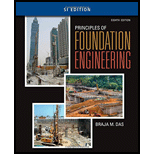
A 20 m long concrete pile is shown in Figure P12.2. Estimate the ultimate point load Qp by
- a. Meyerhof’s method
- b. Vesic’s method
- c. Coyle and Castello’s method
Use m = 600 in Eq. (12.28).

a.
Find the ultimate point load using Meyerhof’s method.
Answer to Problem 9.1P
The ultimate point load using Meyerhof’s method is
Explanation of Solution
Given information:
The length of the concrete pile is 20 m.
Area of the concrete pile
Soil friction angle
Unit weight of sand
Depth
Calculation:
Find the bearing capacity
Substitute 20 m for D and
Refer Table 12.6. “Interpolated values of
The value of
Take the atmospheric pressure
Find the value of ultimate point load
Here,
Find the value of
Substitute
Find the value of
Substitute
Substitute
The ultimate load should satisfy,
Substitute
So take the value of
Therefore, the ultimate point load using Meyerhof’s method is
b.
Find the ultimate point load using Vesic’s method.
Answer to Problem 9.1P
The ultimate point load using Vesic’s method is
Explanation of Solution
Calculation:
Find the modulus of elasticity
Substitute 600 for m and
Find the Poisson’s ratio of the soil using the relation:
Substitute 42 for
Find the value of average volumetric strain in the plastic zone below the pile point
Substitute 42 for
Find the value of rigidity index
Substitute
Find the value of reduced rigidity index
Substitute 66.1 for
Find the mean effective normal ground stress
Substitute
Refer Table 12.8. “Bearing capacity factors
The value of
Find the value of ultimate point load
Substitute
Therefore, the ultimate point load using Vesic’s method is
c.
Find the ultimate point load using Coyle and Castello’s method.
Answer to Problem 9.1P
The ultimate point load using Coyle and Castello’s is
Explanation of Solution
Calculation:
Find the value of
Substitute 20 m for L and 460 mm for D.
Refer Figure 12.20, “Variation of
The value of
Find the value of ultimate point load
Substitute
Therefore, the ultimate point load using Coyle and Castello’s method is
Want to see more full solutions like this?
Chapter 9 Solutions
Principles of Foundation Engineering, SI Edition
- 8-18. Determine the vertical displacement of joint C if member CD is fabricated 10 mm too long. 4m D E B Carrow_forward8-17. Determine the vertical displacement of joint C if members AB and BC experience a temperature increase of ST = 50°C. Take a = 12(10-6)/°C. A 4 m E 4 m 4 m B Darrow_forwardPlease solve all pointsarrow_forward
- For the I section prestressed concrete beam with a straight tendon shown in Fig below which is under the prestressing force, and U.D.L. Analyze the stresses at Mid- span at: A- transfer stage (due to initial prestress P. and self weight wo) B- at service stage. (due to effective prestress Pe and full loads) Check stresses with the ACI permissible stresses. Given: Initial prestress force Pi = 750 kN Effective prestress force Pe = 640 kN Wo (self) = 2.7 kN/m = W (D+L) 8 kN/m e = 130 mm I 5 10 mm² fci = 25 MPa (at transfer age), f' = 35 MPa (at service age) ASECTION 114 000 mm² W=4.75 kN/m |- 12 m F I 610mmarrow_forwardKindly help to provide explanation, examples and provide any useful link for citations and learning purposes. This is regarding building diagnosis.arrow_forwardDescribe the scientific of the arrival of enslaved Africans in America and how it has impacted American societyarrow_forward
- For the beam of cross section shown below, analyze the stresses at Mid-span at transfer and at service stages, Neglect losses. Use: f' =41.4 MPa and assume that concrete has attained strength of fci =34.5 MPa at the time of transfer. The initial prestress force is (Psi-1112 kN). The service deal load D.L = 3.65 kN/m (not include self weight of beam). The service live load L.L=14.6 kN/m. Use n=7. Check stresses with the ACI permissible stresses Determine the equivalent transformed section in compute A and I h=508 mm d=381 9.15 As= 1290 mm² 305arrow_forwardFor the prestressed concrete beam with a straight tendon shown in Fig below which is under the prestressing force of 1620 kN, Analyze the stresses at Mid-span at transfer stage. The uniformly distribution load (self weight) = 4.75 kN/m. Then draw the stress distribution across the section mid-span. W=4.75 kN/m Δ 7.3 m F= 1620 kN 750 mm I 230 mm 500 mmarrow_forward4.36 A pipe slopes upward in the direction of liquid flow at an angle of 30° with the horizontal. What is the pressure gradient in the flow direction along the pipe in terms of the specific weight of the liquid, y, if the liquid is decelerating (accelerating opposite to flow direction) at a rate of 0.3 g?arrow_forward
- 4.25 In this flow passage, the velocity is varying with time. The velocity varies with time at section A-A as 4m V-41/1-230/1 2.25- S to At time t = 0.50s, it is known that at section A-A the velocity gradient in the s direction is +2.1 m/s per meter. Given that to is 0.6 s and assuming quasi-1-D flow, answer the following questions for time t = 0.5 s: a. What is the local acceleration at A-A? b. What is the convective acceleration at A-A? A Diameter 50 cm Problem 4.25arrow_forwardCan you design a (Open Channel): -Most Efficient Section (Rectangle Shape) -Cost Estimate -Structural Analysis Design Requirements: Bed Slope= 1:1500 Manning's (n)= 0.015 Discharge: Q= 18 m^3/sarrow_forwardWhat is Highway engineeringarrow_forward
 Principles of Foundation Engineering (MindTap Cou...Civil EngineeringISBN:9781337705028Author:Braja M. Das, Nagaratnam SivakuganPublisher:Cengage Learning
Principles of Foundation Engineering (MindTap Cou...Civil EngineeringISBN:9781337705028Author:Braja M. Das, Nagaratnam SivakuganPublisher:Cengage Learning Principles of Foundation Engineering (MindTap Cou...Civil EngineeringISBN:9781305081550Author:Braja M. DasPublisher:Cengage Learning
Principles of Foundation Engineering (MindTap Cou...Civil EngineeringISBN:9781305081550Author:Braja M. DasPublisher:Cengage Learning Fundamentals of Geotechnical Engineering (MindTap...Civil EngineeringISBN:9781305635180Author:Braja M. Das, Nagaratnam SivakuganPublisher:Cengage Learning
Fundamentals of Geotechnical Engineering (MindTap...Civil EngineeringISBN:9781305635180Author:Braja M. Das, Nagaratnam SivakuganPublisher:Cengage Learning Principles of Geotechnical Engineering (MindTap C...Civil EngineeringISBN:9781305970939Author:Braja M. Das, Khaled SobhanPublisher:Cengage Learning
Principles of Geotechnical Engineering (MindTap C...Civil EngineeringISBN:9781305970939Author:Braja M. Das, Khaled SobhanPublisher:Cengage Learning



